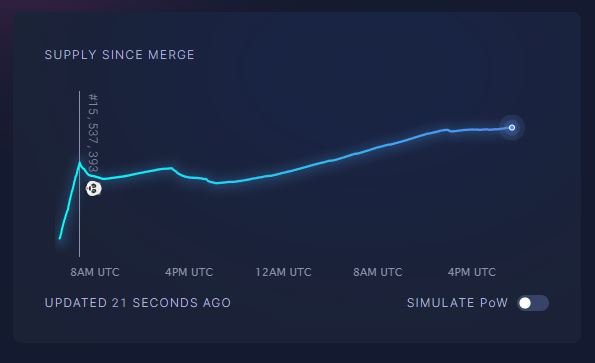While the shift to Proof-of-Stake greatly reduced Ethereum’s ETH emissions, higher transaction fees are necessary for the network’s monetary system to become deflationary.
ETH Total Supply Inflating
Ethereum’s token supply is still increasing despite the blockchain’s transition to Proof-of-Stake.
According to data from ultrasound.money, at the time of writing, Ethereum’s token supply had grown by 418.88 ETH since the blockchain was successfully upgraded on September 15.

Some thought that Ethereum’s switch from Proof-of-Work to Proof-of-Stake, known in the crypto space as the “Merge,” would immediately result in Ethereum’s monetary system becoming deflationary. Unlike “inflationary” money, a deflationary system is characterized by a gradual reduction in the money supply over time.Although the supply of ETH did briefly drop in the immediate aftermath of the Merge (by 248 ETH within twelve hours of the upgrade), it has now reached a new all-time high.
So, did Ethereum’s Merge fail to live up to its promises? Not at all.
Ethereum’s New Monetary Policy
Before the Merge, Ethereum distributed about 13,000 ETH per day to miners (who ran the blockchain’s execution layer) and 1,600 ETH per day to validators (who ran the consensus layer, or the Beacon Chain). At the time, Ethereum’s total supply was inflating by roughly 4.62% a year.
When Ethereum’s execution and consensus layers merged, the blockchain stopped distributing rewards to miners, meaning that ETH emissions dropped by 89.4%. Validators still receive ETH, but they only accounted for 10.6% of the previous rewards. Consequently, ETH yearly emissions decreased to approximately 0.49%.
Furthermore, in August 2021, Ethereum implemented EIP-1559, which introduced an ETH burning mechanism. Ethereum users pay a base fee (denominated in gwei, or one-billionth of 1 ETH) for each transaction. That tax is automatically removed from circulation. Ultrasound.money data indicates that since the upgrade was implemented 407 days ago, a total of 2,625,258.71 ETH has been burned.
However, transaction costs vary depending on how many people (or algorithms) are using the blockchain at any given time. While gas prices are currently sitting at around 12 gwei, they routinely reached 200 gwei during the bull run—on some occasions exceeding 100,000 gwei. According to the Ethereum Foundation, gas fees need to exceed 16 gwei in order for ETH burn mechanism to negate the ETH issued to validators. In other words, ETH’s total supply will increase whenever Ethereum transactions cost 15 gwei or less and decrease if they require 16 gwei or more.
It’s worth repeating that even though Ethereum’s token supply has continued expanding in the wake of the Merge, the decrease in issuance is significant. Without the shift to Proof-of-Stake, the supply would have increased by more than 20,994.04 ETH already—instead of merely 418.88 ETH.
Disclaimer: At the time of writing, the author of this piece owned BTC, ETH, and several other cryptocurrencies.
 cryptobriefing.com
cryptobriefing.com